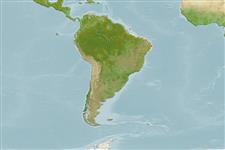Klassifizierung / Names
Namen | Synonyme | Catalog of Fishes(Gattung, Arten) | ITIS | CoL | WoRMS | Cloffa
>
Blenniiformes (Blennies) >
Chaenopsidae (Pike-, tube- and flagblennies)
Etymology: Emblemaria: Latin, emblema = insertion, inlaid work, raised ornament (Ref. 45335); australis: australis in allusion to the distribution of the species, the only member of the genus known to occur in the South Atlantic (Ref. 47837).
Environment: milieu / climate zone / depth range / distribution range
Ökologie
seewasser demersal; tiefenbereich 10 - 30 m (Ref. 47837). Tropical
Southwest Atlantic: Brazil.
Size / Gewicht / Alter
Maturity: Lm ? range ? - ? cm
Max length : 2.7 cm SL (female)
Kurzbeschreibung
Morphologie | Morphometrie
Rückenflossenstacheln (insgesamt): 18 - 20; Rückenflossenweichstrahlen (insgesamt): 32-35; Afterflossenstacheln 2; Afterflossenweichstrahlen: 20 - 22. 3 obvious pelvic fin rays and lacking a flag like flap on the dorsal fin. First dorsal fin spine of males elongate, almost always twice as long as second spine. Palatine teeth 12-15, usually 14. Subdivided supraorbital cirrus in males (Ref. 47837).
Found over rubble and sand bottoms (Ref. 47837).
Life cycle and mating behavior
Geschlechtsreife | Fortpflanzung | Ablaichen | Eier | Fecundity | Larven
Ramos, R.T.C., C.R. Rocha and L.A. Rocha, 2003. New species of Emblemaria (Teleostei: Chaenopsidae) from northern Brazil. Copeia 2003(1):95-98. (Ref. 47837)
IUCN Rote Liste Status (Ref. 130435)
Bedrohung für Menschen
Harmless
Nutzung durch Menschen
Mehr Information
NamenSynonymeMetabolismusRäuberÖkotoxikologieFortpflanzungGeschlechtsreifeAblaichenSpawning aggregationFecundityEierEientwicklung
Alter/GrößeWachstumLänge-GewichtLänge-LängeLängenhäufigkeitenMorphometrieMorphologieLarvenLarven Pop.Dyn.RekrutierungDichteBRUVS
ReferenzenAquakulturAquakultur ProfilZuchtlinienGenetikElectrophoresesVererbbarkeitKrankheitenVerarbeitungNutrientsMass conversion
PartnerBilderStamps, Coins Misc.LauteCiguateraGeschwindigkeitSchwimmstilKiemenoberflächeOtolithsGehirngrößeSehfähigkeit
Tools
Zusatzinformationen
Download XML
Internet Quellen
Estimates based on models
Preferred temperature (Ref.
123201): 27.3 - 27.6, mean 27.4 °C (based on 18 cells).
Phylogenetic diversity index (Ref.
82804): PD
50 = 0.5000 [Uniqueness, from 0.5 = low to 2.0 = high].
Bayesian length-weight: a=0.01000 (0.00244 - 0.04107), b=3.04 (2.81 - 3.27), in cm total length, based on all LWR estimates for this body shape (Ref.
93245).
Trophic level (Ref.
69278): 3.2 ±0.4 se; based on size and trophs of closest relatives
Fishing Vulnerability (Ref.
59153): Low vulnerability (10 of 100).
